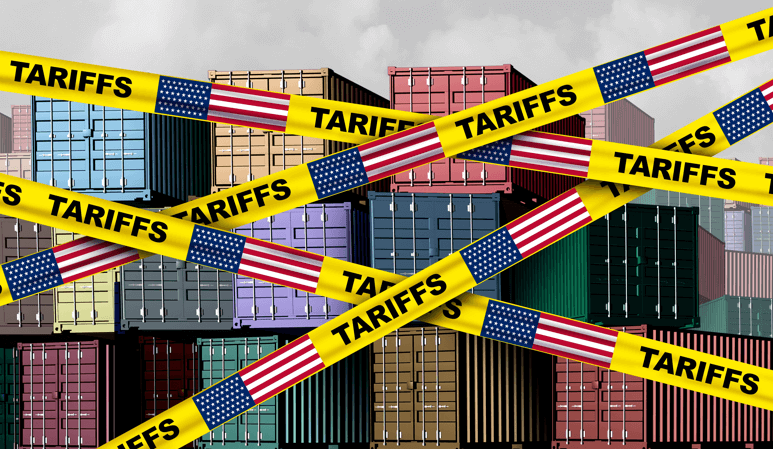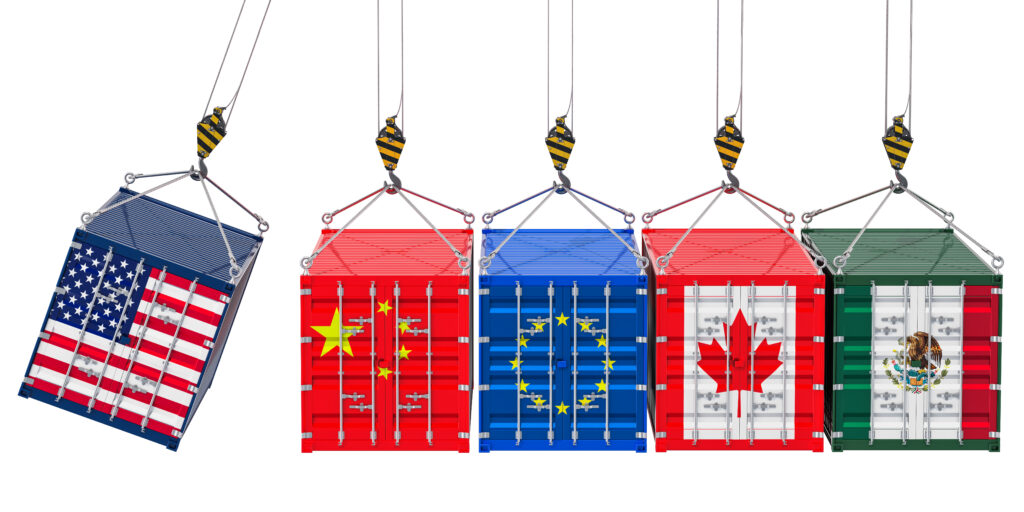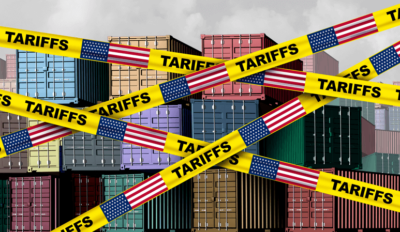Adapting to Tariffs: Six Strategies for Car Dealerships to Protect Profits and Stay Competitive

Tariff disruption isn’t just coming. It’s already underway. Inventory is tightening. OEMs are accelerating shipments, delaying launches, and shifting production priorities to minimize exposure. Some brands are freezing prices or offering last-minute discounts to clear pre-tariff vehicles.
Everyone knows the tariffs are here. What’s less clear is what happens next and how uneven the impact will be. Price hikes won’t roll in all at once. They’ll hit differently depending on brand, model, powertrain, and supply chain exposure. Some automakers will absorb costs. Others will pass them on. Certain models may disappear from lots altogether. And while affordability tightens, consumer behavior becomes harder to predict.
As J.D. Power puts it, this market is “highly fluid.” That means every dealership will feel the squeeze, just not at the same time or in the same way.
You can’t wait for certainty. And you can’t assume yesterday’s playbook will work tomorrow.
Dealers who adapt now, before the auto tariff ripple effects disrupt margins, inventory, and buyer behavior – will be in the best position to stay competitive, protect profits, and lead with confidence, even as the rules keep changing.
In this article
6 Tactical Moves to Stay Competitive During the Tariff Disruption
There’s no one-size-fits-all solution, but there is a way forward. Every dealership will feel the tariff disruption differently. The key is focusing on what you can control: operations, inventory, customer experience, and margin strategy. That’s where the real advantage lies.
In a fluid, high-stakes market, smart execution will be the difference maker.
Here are six tactical moves to help you stay focused, stay profitable, and lead through the disruption – no matter where the market goes next.
1. Get More Out of Fixed Ops—Without Hiring
Fixed ops remains a vital revenue stream, especially with new vehicle affordability challenges ahead. If new car prices rise significantly, your customers are likely to hold on to their vehicles longer and they’ll need more maintenance and repairs. That creates a steady opportunity – if your service department is staffed and set up to meet the moment.
Why This Works:
- Recurring revenue: Service is a consistent money-maker, and with customers keeping their cars longer, the likelihood of them coming back for maintenance and repairs grows. This creates a steady flow of income that can help offset any dips in new car sales
- Customer loyalty: Maintenance bundles and warranties don’t just bring customers back for service; they help retain them for future vehicle purchases, too.
Actionable Strategies:
- Expand Service Capacity: Aging vehicles and slower new car sales mean higher RO volume and increased demand for repair work. Ensure you have the right staffing, skill sets, and parts in place to service the demand. More throughput equals more revenue, especially if capacity keeps pace.
- Turn Powertrain Change into Profit: Used EVs and hybrids are entering the market in greater volume – often across multiple brands and increasingly out of warranty. That opens the door for dealerships that are trained and equipped to service them. Independent shops often aren’t ready, so position your store as the trusted go-to. And if you’re shifting your inventory toward used EVs, hybrids, or PHEVs, your service lane needs to match. This is a real opportunity to turn evolving powertrains into steady fixed ops revenue, even as front-end volume slows.
- Offer Maintenance Packages: Think about bundling things like oil changes, tire rotations, and brake checks into prepaid service packages. Lock in recurring revenue, improve RO frequency, and boost long-term customer retention. Predictable cash flow and higher RO frequency improve both profitability and absorption.
- Promote Extended Warranties: Extended coverage boosts long-term service lane revenue and improves F&I gross. It adds value to the customer and stabilizes service income.
- Upsell Accessories and Upgrades: When your customers bring their vehicles in for service, use that opportunity to recommend accessories or upgrades like custom wheels, roof racks, or tech upgrades. It’s a lower frequency opportunity but very high margin. Good for increasing average RO value, but dependent on customer willingness and service advisor execution.
- Optimize Parts Inventory: This is an indirect profitability play. With tariffs raising costs and lead times, explore alternative suppliers for better pricing. A just-in-time model still works, but it’s smart to carry a buffer on critical, high-turn, or tariff-sensitive parts. Prioritize what keeps your service lane moving. A hybrid approach protects margins, avoids delays, and keeps cash flow healthy.

2. Follow the Demand
Vehicle prices are already near record highs, and they are likely to climb in the weeks and months ahead. As affordability tightens, buyer demand will continue to shift, with used vehicles – especially CPOs – becoming the preferred option for a larger share of your customer base. It’s not just a short-term reaction. It’s part of a longer-term trend. Meanwhile, limited EV availability and rising tariff-driven costs are likely to push more interest toward fuel-efficient gas models, hybrids, and PHEVs. The economic impact of the tariffs is already shifting what customers consider ‘affordable’ – and what turns taster. Dealers who adapt now will stay ahead of the curve and in front of the customer.
Why it Works:
- Higher margins: CPO and used vehicles often carry better front-end grosses than new cars—especially when well maintained, sourced and priced strategically. They also turn faster when aligned with current demand.
- Built-in demand: As new prices climb, more buyers are actively looking for high-quality alternatives. CPOs hit the sweet spot between peace of mind and affordability, making them the preferred option for value-focused shoppers.
- Lineup Flexibility: Hybrids, PHEVs, and fuel-efficient ICE models give you options. Whether you’re dealing with price-sensitive buyers, limited EV supply, or rising monthly payments, these vehicles help you stay competitive across segments – even among non-EV shoppers.
Actionable Strategies:
- Make CPOs Your Profit-Protecting Advantage: Position your CPO inventory strategically as a low-risk, high-confidence alternative to new cars – while reinforcing that value through consistent messaging on your website and in-store displays. Use high-level checklists on VDPs and showroom POS to highlight key benefits. Internally, optimize your reconditioning and stocking processes to focus on fast-turning, certifiable units that protect front-end gross. CPO isn’t just a safer choice for buyers, it’s a smarter play for your bottom line.
- Expand Used Car Financing Options: Many buyers hesitate to finance used cars due to interest rates or long-term commitments. Partner with your F&I team to offer competitive financing, flexible terms and leasing options. Leasing used vehicles can help customers secure lower monthly payments while avoiding the full financial burden of a new car.
- Train for Value-Focused Conversations: Equip your sales team to sell total value – not just price. Focus on long-term savings, reliability, and lower ownership costs (e.g., fuel, insurance, maintenance). This resonates especially with buyers under $35K budgets who are comparing new vs. used options. This approach makes it easier for customers to see the value of buying a pre-owned vehicle versus a new one, ultimately driving conversions.
- Promote a “Smart Drive” Lineup: Build and market an inventory mix that includes hybrids, PHEVs, fuel-efficient gas models, and used EVs. These aren’t just eco options, they are budget-friendly, payment-friendly choices that appeal to today’s cost-conscious buyer. Many shoppers aren’t looking to “go green”. They’re looking to avoid the high upfront cost of full EVs or the pain at the pump. Emphasize efficiency, value, and availability over eco credentials to broaden your appeal. Online, create dedicated inventory filters or landing pages to highlight your “Smart Drive” lineup. In-store, train your team to lead with cost-saving benefits, not environmental ones.
3. Make Affordability Work
As vehicle prices rise and affordability tightens, flexible financing and well-timed promotions are no longer nice-to-have. They’re competitive necessities. The right strategy helps you close deals without slashing margins, gives price-conscious buyers a path to say “yes,” and keeps your volume strong even as sticker shock sets in.
Why it Works:
- Reduces price hesitation: Strategic financing helps reduce upfront cost concerns and gives buyers the confidence to commit – especially those comparing monthly payments, not MSRPs.
- Creates urgency: Well-timed special offers like trade-in bonuses or service credits boost perceived value and encourage faster decisions.
- Drives loyalty: Customized financing or loyalty perks show buyers you understand their needs—leading to higher retention and repeat business.
Actionable Strategies:
- Explore Flexible Financing Options: Not every customer is chasing a discount. Many just want a monthly payment they can live with. That’s where strategic financing can make a difference. You don’t need new lender programs, but you do need to work with what actually fits your customers’ credit and budget realities. Structure deals the way your buyers think and shop without giving up front-end gross.
Start by knowing your lenders’ sweet spots. Some offer better terms at 72 or 84 months. Others compete on rates or offer subvented used car programs. Partner with your F&I team to match the right lender to the right buyer—and use rate spreads and reserve wisely to keep payments in the comfort zone without killing your gross. And if you’re not already doing it, explore underutilized options like:
- Used vehicle leasing for select models
- First-payment deferrals or holiday-payment promotions
- Service or warranty add-ons that enhance value without lowering price
Affordability doesn’t always mean cutting prices. Sometimes, it just means structuring the deal in a way that makes sense to the buyer. With auto tariffs pushing prices even higher, affordability is becoming a moving target.
- Use Incentives with Purpose: Discounts aren’t your only lever and they’re often the worst one. The right incentive builds urgency, increases perceived value, and helps protect your front-end gross.
Focus on trade-in bonuses, service credits, or loyalty perks that give the customer more without dropping the price. Structure offers that reward fast action or target specific inventory segments (like CPOs or vehicles in the $30K–$40K range).
Promote these offers clearly on your website, in your campaigns, in your follow-ups, and during sales conversations. And most importantly, make sure your team is framing them as value adds, not last-minute giveaways.
- Tailor Offers by Buyer Segment: Every customer segment feels affordability pressure differently – and each responds to a unique mix of financing, incentives, and messaging. Use the examples below as building blocks to craft targeted offers that align with your most active segments and reduce friction where it matters most: at the point of sale.
| Segment | Challenges | Financing & Promo Ideas | Refined Messaging Tip |
| First-Time Buyers | Limited credit history, affordability anxiety, fear of long-term commitment | Low down payment, lower interest rates, complimentary maintenance, extended warranty options | “Your first car shouldn’t be stressful. We’ll help you drive with confidence and peace of mind.” |
| Young Professionals | Budget-conscious but value status and flexibility; prefer lower monthly commitments | Sub-$250/mo leases on hybrids or sedans, low-interest loans, tech-forward and practical options | “Drive something that fits your ambition. Smart payments. Great mileage. Built for what’s next.” |
| Budget-Conscious Buyers | Highly sensitive to price increases and monthly payment spikes | Trade-in incentives, extended loan terms, emphasize total cost of ownership (fuel, insurance savings) | “Stretch your budget without cutting corners. More value, less stress – right when you need it most.” |
| Repeat Customers | Expect recognition for loyalty and may be open to trade-ins or upgrades | Trade-in bonuses, loyalty perks, upgraded warranty or service packages, exclusive returning customer offers | “Loyal customers deserve more. Let us help you get even more from your next car.” |
| Retirees/ Seniors | Fixed income; prioritize ease of ownership, low maintenance, and dependability | 0% financing for 60 months, low-mileage vehicles, prepaid maintenance, easy-access models | “Simple, worry-free car buying—with service perks that go the extra mile.” |
4. Stock for Speed and Profit
Forecasting what’s coming is tricky, but with auto tariffs driving up new car prices, your inventory mix needs to work harder. That means offering the right balance of value, reliability, and availability across a range of price points. Whether your dealership attracts budget-conscious shoppers, high-value buyers, or customers focused on fuel savings, a well-diversified lineup of used vehicles and CPOs will help you meet more of the market, more of the time.
Why It Works:
- Stronger margins, faster turns: Used vehicles, especially CPOs, tend to deliver better front-end margins than new cars. And with the right mix, they move quickly, freeing up capital and boosting profitability.
- Wider buyer appeal: A thoughtful used inventory helps you serve more segments – from price-sensitive buyers looking for value, to those seeking fuel efficiency, brand reliability, or specific features without the new car price tag.
Actionable Strategies:
- Build a High-quality Used Pipeline: Source from a broad mix: lease returns, trade-ins, fleet and rental sales, service lane mining, auctions, and private sellers. Tap into digital dealer-to-dealer networks and online marketplaces to find the right cars faster and often at better margins than traditional lanes – especially in the under-$40K range where buyers are most active.
- Prioritize Tariff-exposed Models: Focus on low-mileage, late-model used versions of high-demand vehicles from tariff-impacted brands, like those from Asia and Europe. Trucks and midsize SUVs in particular may be harder to justify new, so used options can be a great alternative for buyers and a high-margin opportunity for you.
- Expand Your Powertrain Mix: With EV supply tightening and incentives potentially fading, now’s the time to diversify. Stock fuel-efficient ICE vehicles, hybrids, PHEVs, and used EVs. These aren’t just eco options anymore, they’re smart financial plays for budget-conscious buyers and families trying to beat rising costs at the pump.
- Stock a Strong Cross-brand Selection: Some customers care more about the deal than the badge. A diverse used inventory across multiple brands gives you a better shot at catching buyers who are shopping value, not loyalty – and gives you more margin flexibility across categories.
- Meet Rising Demand for U.S.-built Vehicles: Vehicles with fewer imported parts may be less affected by tariff increases and in today’s economy, more buyers want to “buy American.” Leverage that sentiment in how you source and position inventory.
5. Make Buying Easy. Make Selling Easier
Tariffs are making affordability a bigger issue and finance anxiety is keeping some buyers from walking through your doors at all. That’s why your website needs to do more than just showcase inventory. It should make it easy for hesitant, price-sensitive customers to take the next step – on their terms. The goal is to reduce friction, ease uncertainty, and build confidence from the first online interaction.
Why It Works:
- Addresses buyer hesitation early: Many shoppers are stalling out online, not because they aren’t interested, but because the path forward feels unclear or intimidating. Making financing and trade-in options easier to understand gives them a reason to re-engage.
- Improves conversion and lead quality: The more confident a buyer feels online, the more qualified they are when they reach your showroom. A smoother digital experience weeds out unnecessary drop-off and boosts lead-to-sale ratios.
- Builds trust in a high-anxiety market: Shoppers are wary of hidden costs and unclear next steps. Transparency, control, and personalization – especially around payments – help build the trust that leads to action.
Actionable Strategies:
- Connect Payment Calculator to Credit Application: Link your payment calculator tool directly to your credit app so customers can see real numbers in real-time based on your actual credit tiers, not generic estimates. It sets realistic expectations, builds trust early, and eases affordability concerns. That kind of transparency keeps buyers engaged and opens the door to smarter, more tailored offers that convert.
- Remove the Pre-qualification Barriers: Most online credit applications still feel like tax forms. If you’re using a third-party solution, evaluate whether their experience is helping or hurting your conversion. Look for solutions that break the process into short, friendly steps and avoid asking for a SSN or DOB upfront. Use plain language, not jargon. The best platforms also include tips or explainer videos that walk buyers through what to expect. A credit experience that feels approachable isn’t just good UX, it’s a trust signal.
- Streamline Pricing Conversations: Today’s buyers want to participate in the process—including pricing conversations. Give them a way to ask questions, negotiate, or get a ballpark deal before ever walking in. Tools like chat-based pricing discussions create a low-pressure path for hesitant shoppers to engage. They also help your BDC or internet team qualify leads faster, shorten the sales cycle, and reduce friction once the customer steps into the store.
- Use AI Chatbots to Guide, Not Just Respond: A smart chatbot can do a lot more than just answer questions. It helps move buyers forward by guiding them through key steps without the friction of form fills. Need real-time inventory availability? Done. Want to get pre-approved, schedule a test drive, value a trade-in, or explore payment options? All of that can happen in the chat. Some even recognize buying signals and start the conversation for you. It’s always on, always available – for buyers who aren’t ready to talk to a salesperson but are definitely ready to move.
- Highlight Total Value, Not Just Price: Go beyond just showcasing price and listing features. Make it easy for customers to see what sets your dealership apart. Put value-based benefits—like warranty coverage, service plans, special financing, and trade-in offers—front and center. Back it up with customer testimonials. It reframes affordability and helps hesitant value-driven buyers move toward a “yes.”
6. Smarter Ops. Stronger Margins.
Tariffs will start squeezing sales. Operating costs will start climbing. That makes protecting your margins more important than ever. But smart cost control doesn’t mean cutting corners. It means streamlining how you work, reducing waste, and getting more from the tools you already have. The best part? You don’t need to invest in new tech to stay competitive. With sharper execution and a willingness to adapt – you can stay agile, protect profitability, and still deliver a consistent, high-level customer experience.
Why this works:
- Efficiency boost: Streamlining lets you allocate staff, capital, and inventory more strategically – cutting waste without cutting quality.
- Better decisions, faster: Your CRM, DMS, and inventory tools are full of insights. Tapping into that data helps you fine-tune pricing, promotions, and processes – all of which help boost margins.
- Low-cost gains: Small tweaks – like better scheduling or smarter contract terms – can unlock real savings and free up cash without impacting your service or sales flow
- Tech ROI without big spend: Most dealers already have the tools—they’re just not using them to their full potential. A little more usage of what you already own can yield a lot more margin.
Actionable Strategies:
- Leverage Dynamic Pricing Tools: Explore the pricing capabilities within your DMS or inventory management platform, or consider integrating a third-party dynamic pricing solution. This will allow you to adjust prices based on real-time market conditions and vehicle age, ensuring your prices remain competitive and reducing the need for blanket discounts or ‘too late’ markdowns that eat into profits.
- Reduce Operational Costs: Review your dealership’s cost structure to identify inefficiencies. For instance, use appointment scheduling software to optimize service technician time, reducing idle periods. Explore other areas like streamlining the reconditioning process and administrative tasks, where small adjustments can create lasting savings without compromising quality or customer care.
- Negotiate Supplier Terms: Work with your suppliers and manufacturers to understand the real impact of tariffs on imported parts and negotiate for rebates, discounts, or more favorable terms to offset cost increases. This helps maintain competitive pricing while preserving margins, ensuring you aren’t forced to pass on all the tariff increases to customers.
- Data-driven Inventory Optimization: Leverage your inventory management platform to combine real-time sales data with local market insights to understand which models are popular, what’s likely to be in demand soon and which ones may be impacted the most by tariffs. For instance, if you notice a local surge in demand for mid-sized sedans due to rising fuel costs and tariff-related price hikes on larger SUVs, you can adjust your inventory to prioritize sourcing sedans and compact vehicles that are less affected by tariff increases – and tailor marketing efforts around the demand. By analyzing the data, you can proactively adjust your inventory sourcing and sales strategies, ensuring you stay ahead of market trends, optimize turnover, and maintain competitive, profitable pricing.
- Maximize Your CRM Data: Your CRM isn’t just a lead bucket—it’s loaded with behavioral insight most dealers barely touch. Segment customers by buying patterns, preferences, and price sensitivity to build smarter campaigns that actually move people down the funnel – without chasing every lead by hand. For example: Spot customers who bought budget sedans three years ago and hit them with trade-in offers and upgrade financing on mid-size SUVs. You’re not just marketing. You’re solving a problem they already have. This is how you turn data into revenue. Not just more clicks, more deals closed.
- Manage Vendor Contracts: Tariff-related cost creep doesn’t just hit your inventory. It can show up in vendor contracts, from shipping to software and add up quickly. For example, a logistics provider might pass on increased shipping costs, or a software company might raise subscription prices if their product is tied to imported components. Renegotiate service contracts to manage tariff-related cost increases and secure favorable terms or find vendors with less exposure.
The Road Ahead
Tariff impacts bring uncertainty, but this industry has weathered bigger storms and come out stronger. From Cash for Clunkers to COVID, electrification to chip shortages, the dealers who adapt are the dealers who win. This moment is no different.
Focus on what you can control. Double down on customer care. Strengthen your fixed ops. Get more from your used car operation. And put your existing tools to better use.
You don’t need to overhaul your business. You just need to fine-tune the right parts. Do that, and you’ll stay competitive, protect your margins, and keep moving forward – no matter what comes next.



